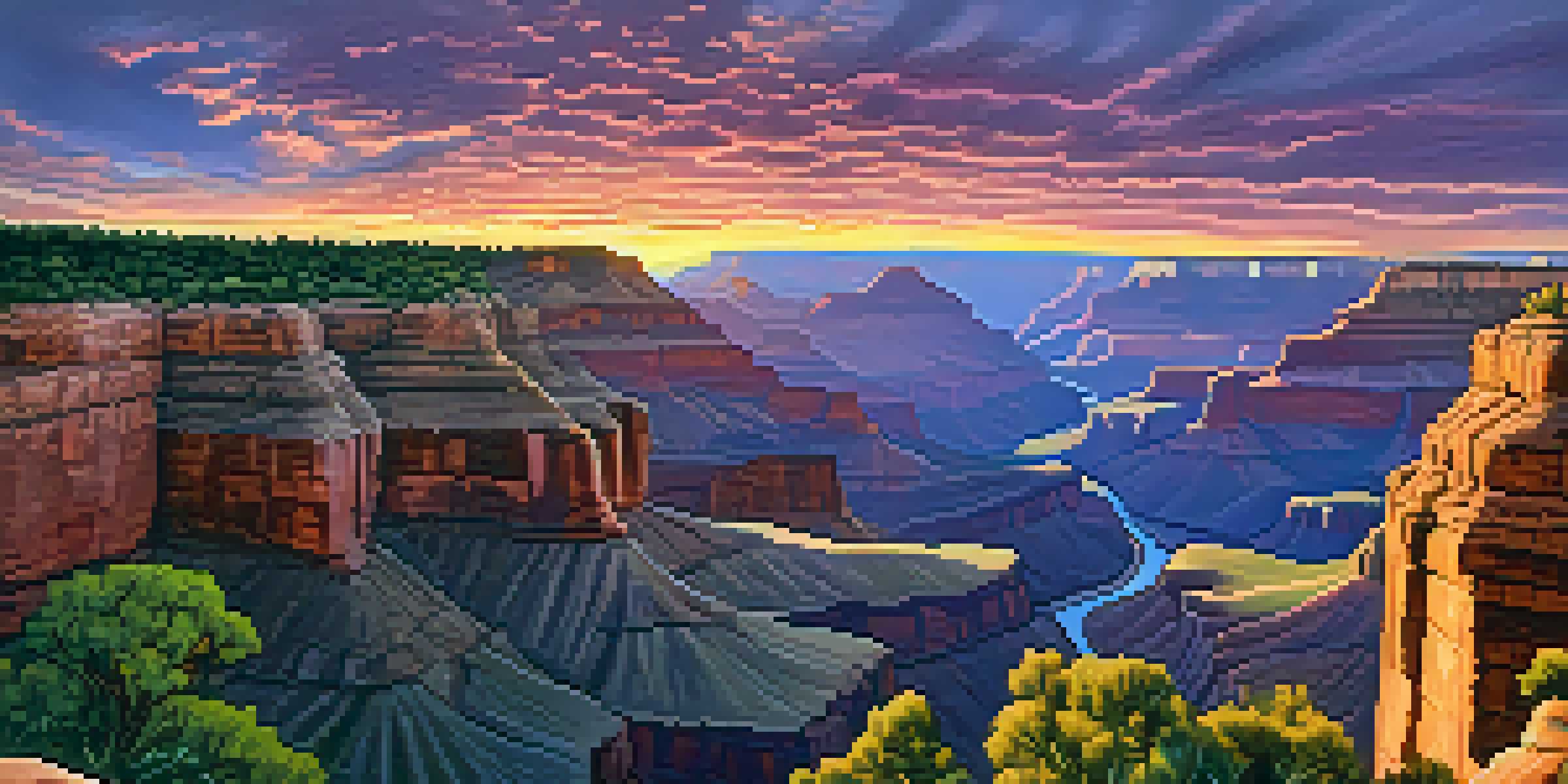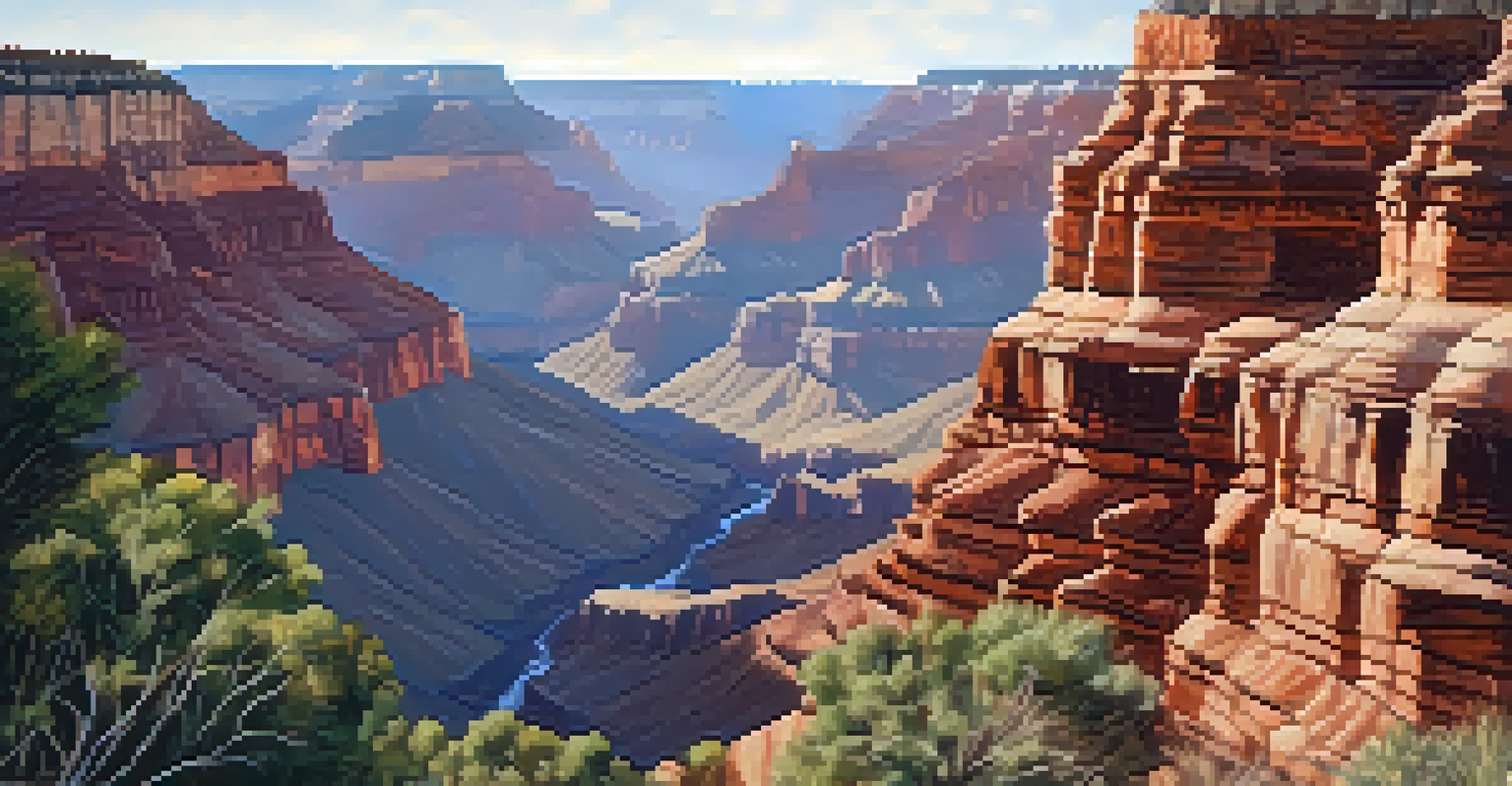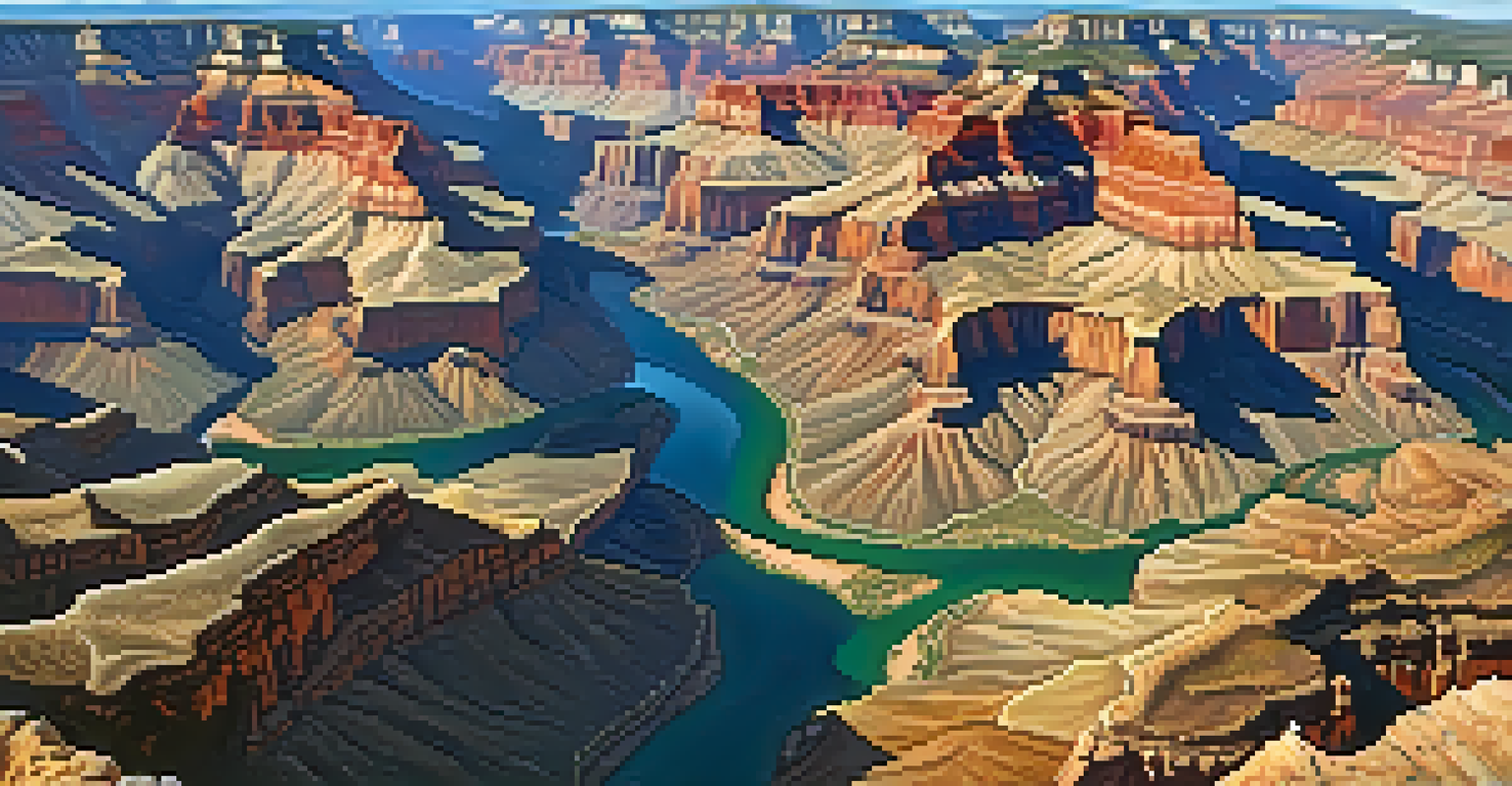Exploring the Grand Canyon's Layers of Geological History

The Grand Canyon: A Geological Wonder
The Grand Canyon is not just a breathtaking sight; it's a geological treasure trove. With its vast expanse of colorful rock layers, each telling a story that stretches back millions of years, the canyon is a living museum of Earth's history. Visitors often stand in awe, not just at its beauty, but at the secrets buried within its walls. This natural wonder showcases the dynamic processes that shaped our planet over eons, making it a must-see for any geology enthusiast.
The Grand Canyon is a natural wonder that showcases the beauty of our planet and the power of nature's forces.
As you gaze at the canyon's layered walls, you might wonder how these formations came to be. The answer lies in the natural forces of erosion, sedimentation, and volcanic activity that have sculpted the landscape over time. Each layer you see represents a specific period in geological history, with fossils and minerals offering clues about the environment that existed long ago. It's like reading a book, with each chapter revealing a different era of Earth's past.
Exploring the Grand Canyon is a journey through time. From ancient seas to arid deserts, each layer reflects significant climatic shifts and geological events. Understanding this history not only enriches your visit but also deepens your appreciation for the planet's ever-changing nature.
The Rock Layers: A Timeline of Earth's History
The Grand Canyon's walls are a visual timeline, with rock layers that span nearly 2 billion years. The oldest rocks at the bottom, known as the Vishnu Schist, are remnants of ancient oceanic crust, formed deep beneath the Earth’s surface. As you ascend the canyon, you encounter younger sedimentary layers, each representing different geological periods. This vertical arrangement of rocks allows geologists to piece together a coherent story of the Earth's development.

Each layer has its own unique characteristics, such as color, composition, and fossil content. For instance, the bright red rocks of the Supai Group indicate a time when the area was covered by a vast desert. In contrast, the gray limestone of the Redwall Limestone hints at the presence of ancient oceans. These differences paint a vivid picture of the environmental shifts that have occurred over millennia.
The Grand Canyon's Geological Layers
The Grand Canyon's rock layers provide a visual timeline of nearly 2 billion years of Earth's history, showcasing significant geological events.
By studying these layers, scientists can not only understand the history of the Grand Canyon but also gain insights into global geological processes. The canyon serves as a natural laboratory, allowing researchers to study past climates, sea levels, and even the evolution of life on Earth.
Fossils: Evidence of Life Through the Ages
Fossils found within the Grand Canyon's rock layers provide a fascinating glimpse into the life forms that once inhabited the area. From marine creatures to land-dwelling dinosaurs, these remnants tell the story of a vibrant ecosystem that existed long before humans walked the Earth. The presence of marine fossils in the canyon's higher layers is a testament to the area's shifting environments over time.
In every walk with nature, one receives far more than he seeks.
For example, trilobites and brachiopods, which thrived in ancient seas, are commonly found in the sedimentary rocks of the Grand Canyon. These fossils not only highlight the diversity of life but also illustrate how life adapted to changing conditions. Each fossil serves as a marker, indicating the type of environment that prevailed at that time.
The study of these fossils is crucial for understanding the evolutionary history of life on Earth. By examining the fossil record, scientists can trace the development of different species and their responses to environmental changes, offering valuable lessons that resonate even today.
The Role of Erosion in Shaping the Canyon
Erosion is a powerful force that has significantly shaped the Grand Canyon over millions of years. Water, wind, and ice constantly wear away the rock layers, carving the intricate landscape we see today. The Colorado River plays a central role in this process, cutting through the rock and deepening the canyon as it flows. This relentless force of nature is responsible for the canyon's stunning vistas and unique formations.
As you hike along the canyon's rim or descend into its depths, you can observe the various erosional features, such as buttes, mesas, and spires. These formations are a direct result of erosion, showcasing the intricate dance between water and rock. The interplay of different elements creates a diverse landscape that draws visitors from around the globe.
Cultural Significance of the Canyon
The Grand Canyon is a sacred place for Indigenous peoples, with rich cultural traditions that highlight its historical importance.
Understanding erosion's role in the Grand Canyon not only enhances our appreciation for its beauty but also highlights the importance of protecting such natural wonders. The ongoing processes of erosion remind us of nature's power and the need to preserve these geological treasures for future generations.
Volcanic Activity and the Canyon's Formation
While the Grand Canyon is primarily known for its sedimentary layers, volcanic activity has also played a crucial role in its formation. Several volcanic eruptions in the region contributed to the canyon's geology, adding layers of basalt and other volcanic rock. These eruptions not only shaped the landscape but also influenced the ecosystems that developed within the canyon.
One prominent example is the Lava Falls, a dramatic rapid in the Colorado River formed by a volcanic eruption. The hardened lava rock creates a striking contrast against the surrounding sedimentary layers, showcasing the dynamic nature of the canyon's geology. These volcanic features remind us that the Grand Canyon is a product of both erosion and volcanic forces, working in tandem over millions of years.
By studying the volcanic history of the Grand Canyon, scientists gain insights into the region's geological evolution. This knowledge helps us understand how volcanic activity can impact landscapes and ecosystems, further enriching our comprehension of Earth's ever-changing nature.
Cultural Significance of the Grand Canyon
The Grand Canyon is not only a geological marvel but also holds immense cultural significance for many Indigenous peoples. For centuries, tribes such as the Havasupai, Hualapai, and Navajo have considered the canyon a sacred place. Their stories and traditions are deeply intertwined with the land, reflecting a rich cultural heritage that predates modern exploration by thousands of years.
Visitors to the Grand Canyon can gain a deeper understanding of its cultural importance through various interpretive programs and guided tours offered by Indigenous communities. These experiences provide insight into the spiritual and historical connections that exist between the land and its original inhabitants. Learning about these perspectives enhances our appreciation for the canyon beyond its physical beauty.
Importance of Preservation Efforts
Conservation initiatives are vital to protect the Grand Canyon's ecosystems and ensure its beauty and significance endure for future generations.
Recognizing the cultural significance of the Grand Canyon is essential for fostering respect and understanding. As we explore this natural wonder, it's important to acknowledge the rich history and traditions that have shaped the landscape, reminding us that the Grand Canyon is as much about people as it is about geology.
Preserving the Grand Canyon for Future Generations
As we marvel at the Grand Canyon's beauty and geological significance, it's crucial to consider the importance of preservation. With millions of visitors each year, the impact on the environment can be significant. Conservation efforts are essential to protect the canyon's delicate ecosystems and ensure that future generations can experience its wonders as we do today.
Organizations dedicated to conservation work tirelessly to address issues such as litter, trail maintenance, and wildlife protection. These initiatives aim to balance tourism with environmental stewardship, ensuring that the canyon remains a pristine natural environment. Everyone can play a part in this effort, from practicing Leave No Trace principles to supporting local conservation programs.

By prioritizing preservation, we honor the Grand Canyon's rich geological history and cultural significance. Together, we can ensure that this magnificent landscape continues to inspire and educate visitors for generations to come, maintaining its status as one of the world's most cherished natural wonders.